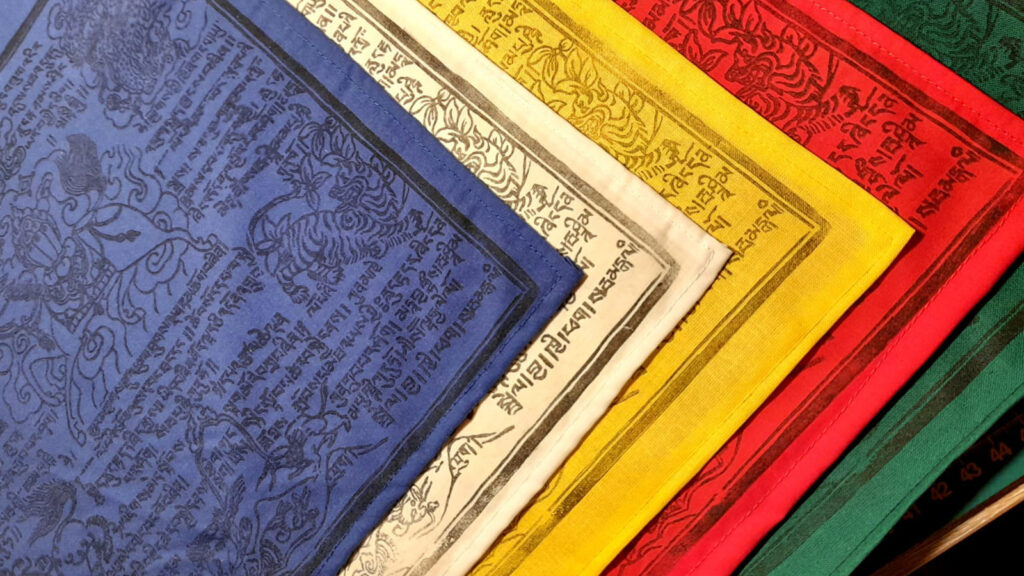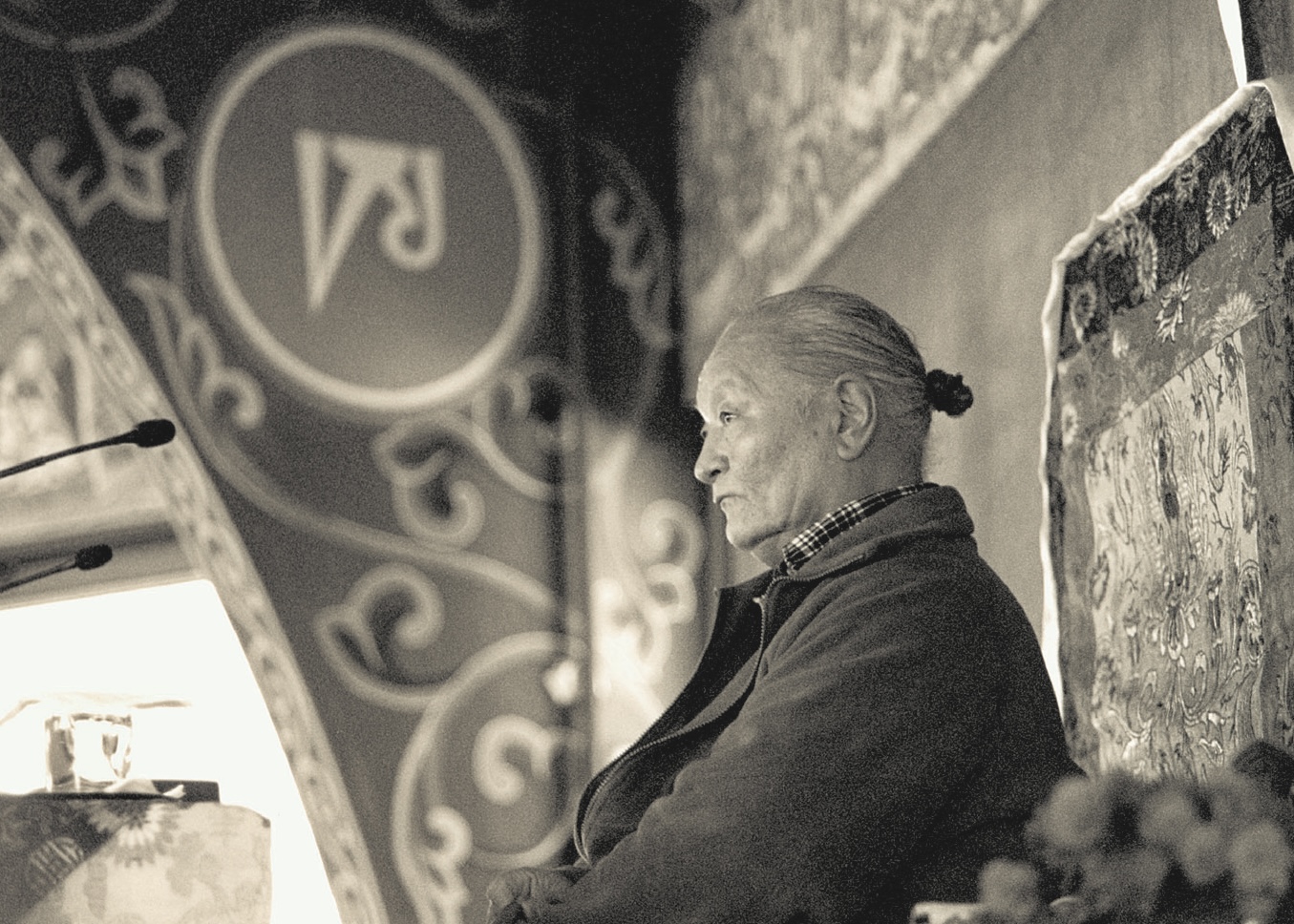
SUPPORT DZAMLING GAR AND HAVE YOUR PRAYER FLAGS HUNG!
This year, our Lungta are prepared in a very special way, adhering to the principles of sustainability. The fabric consists of 100% cotton, and all Lungta are cut, and printed by hand, and sewed by our volunteers here in Dzamling Gar.
For those interested in benefiting their homes with handmade Lungta, we offer the option to order a delivery of consecrated Lungta from Dzamling Gar to your home. Your purchase contributes to the development and maintenance of Dzamling Gar.
We only have a limited quantity of:
- 200 horizontal flags (4 sets of 5 coloured lungta = 20 flags) for the suggested donation €40.
- 200 horizontal flags (2 sets of 5 coloured lungta = 10 flags) for the suggested donation €20.
- 50 big vertical flags for the suggested donation €60.
- Unlimited quantity of Lungta consecrated in Dzamling Gar of horizontal flags (4 sets of 5 coloured lungta = 20 flags) shipped to you for the suggested donation of €50.
ORDER YOUR FLAGS NOW AND SUPPORT DZAMLING GAR!

LUNGTA TIBETAN PRAYER FLAGS
Chögyal Namkhai Norbu´s words about Lungta:
"The word lungta (ཀླུང་རྟ་, klung rta) is composed of two syllables: the first, lung, represents the element 'space' in the fivefold classification of the elements 'earth, water, fire, air and space' and signifies 'universal foundation' or 'omnipervasiveness'. [...]
The second syllable ta (horse) refers to the 'excellent horse' (རྟ་མཆོག་, rta mchog), and since in ancient times in Tibet the horse was the symbol of travelling with the greatest speed, in this case it seems to refer to the transmutation of every thing that depends on the five elements from negative to positive, from bad to good, from misfortune to good fortune, from baleful portents to auspicious signs, from poverty to prosperity, and it implies that this should ensue with the greatest speed. [...]
I believe this to be the true meaning of lungta. In more recent times the custom has arisen of spelling this word རླུང་རྟ་, rlung rta (wind horse), ascribing to it the meaning 'that which rides the wind', but I think this is derived from the practical function of the lungta flags of being raised in the sky and moved by the wind."
Hanging prayer flag is very beneficial, and especially hanging the Lungta (windhorse – meaning powerful or strong horse) prayer flag will bring protection, victory and success, transforming misfortune to happiness.

SHORT STORY OF LUNGTA
There are two kinds of prayer flags: horizontal ones, called Lung ta (meaning “Wind Horse”) in Tibetan, and vertical ones, called Darchor (meaning “flagstaff”). Lung ta (horizontal) prayer flags are of square or rectangular shape, and are connected along their top edges to a long string or thread. They are commonly hung on a diagonal line from high to low between two objects (e.g., a rock and the top of a pole) in high places such as the tops of temples, monasteries, stupas, and mountain passes.
Darchor (vertical) prayer flags are usually large single rectangles attached to poles along their vertical edge. Darchor are commonly planted in the ground, mountains, cairns, and on rooftops, and are iconographically and symbolically related to the Dhvaja.
Traditionally, prayer flags come in sets of five: one in each of five colors. The five colors are arranged from left to right in a specific order.The five colors represent the five elements and the Five Pure Lights. Different elements are associated with different colors for specific traditions. Blue symbolizes the sky and space, white symbolizes the air and wind, red symbolizes fire, green symbolizes water, and yellow symbolizes earth. According to Traditional Tibetan medicine, health and harmony are produced through the balance of the five elements.Traditionally, prayer flags are used to promote peace, compassion, strength, and wisdom. The flags do not carry prayers to gods, which is a common misconception; rather, the Tibetans believe the prayers and mantras will be blown by the wind to spread the good will and compassion into all pervading space. Therefore, prayer flags are thought to bring benefit to all.By hanging flags in high places the Lungta will carry the blessings depicted on the flags to all beings. As wind passes over the surface of the flags, which are sensitive to the slightest movement of the wind, the air is purified and sanctified by the mantras.
The prayers of a flag become a permanent part of the universe as the images fade from exposure to the elements. Just as life moves on and is replaced by new life, Tibetans renew their hopes for the world by continually mounting new flags alongside the old.This act symbolizes a welcoming of life’s changes and an acknowledgment that all beings are part of a greater ongoing cycle. Because the symbols and mantras on prayer flags are sacred, they should be treated with respect. They should not be placed on the ground or used on clothing. Old prayer flags should be burned.
